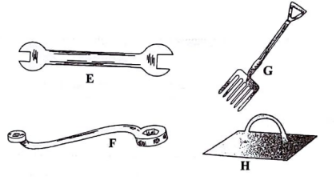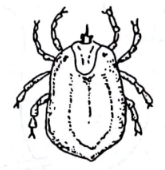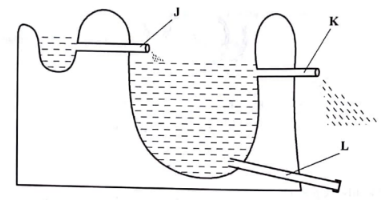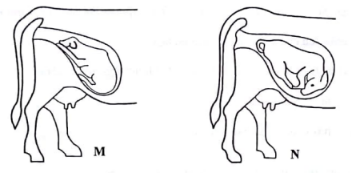Instructions to candidates
- This paper consists of three sections: A, B and C.
- Answer all the questions in sections A and B.
- Answer any two questions in section C
- Candidates should answer all the questions in English.
SECTION A (30 marks)
Answer all the questions in this section in the spaces provided.
- Name one breed of livestock under each of the following categories:
- dairy cattle .........................(½ mark)
- dual purpose cattle .................(½ mark)
- dual purpose sheep .................(½ mark)
- hair goat .....................(½ mark)
- State four egg abnormalities observed during egg candling. (2 marks)
- Give four reasons for livestock breeding. (2 marks)
- Give two reasons for hoof trimming. (1 mark)
- State four signs of Anthrax disease. (2 marks)
- Name four methods of dehorning. (2 marks)
- Give four reasons for keeping dairy animals healthy. (2 marks)
- State four features of a clean milkman. (2 marks)
- Name four maintenance practices for a wire fence. (2 marks)
- State four reasons why dorper breed of sheep is good for mutton production. (4 marks)
- State four control measures for tsetse flies. (2 marks)
- Explain how each of the following is measured in cattle:(
- blood temperature (½ mark)
- respiratory rate (½mark)
- pulse rate. (½ mark)
- State the gestation period for each of the following:
- Cow (½ mark)
- Sow (½mark)
- Ewe (½ mark)
- rabbit. (½ mark)
- State four features of large white breed of pigs. (2 marks)
- State four functions of worker bees in a bee colony. (2 marks)
- State three ways of caponisation in poultry. (1½ marks)
SECTION B (20 marks)
Answer all the questions in this section in the spaces provided.
- The diagrams below represent farm tools and equipment.
- Identify the tools labelled E and F. (2 marks)
- State one use of each of the tools labelled F and G (2 marks)
- State one advantage the tool labelled F has over E. (1 mark)
- The diagram below illustrates an external parasite of livestock.
- Identify the parasite. (1 mark)
- Apart from eggs and adults, name two other developmental stages of the parasite illustrated above. (1 mark)
- Name two livestock diseases transmitted by the illustrated parasite. (1 mark)
- Explain two ways in which the environment is altered to control the parasite illustrated above. (2 marks)
- The diagram below shows a cross section of a fish pond
- Name the part labelled J and K (2 marks)
- State one function of the part labelled L (1 mark)
- Give one reason why a pond should have a deep end. (1 mark)
- Explain how fingerlings are introduced into a pond? (1 mark)
- The diagram below shows calf presentations during parturition.
- Name the presentation labelled M and N (2 mark)
- Which one of the two presentations requires the services of a qualified stockman? (1 mark)
- State two signs of parturition observed on the vulva. (2 marks)
SECTION C (40 marks)
Answer any two questions from this section in the spaces provided after question 23.
-
- Describe ten characteristics of a good layer. (10 marks)
- Describe the milking procedure under the following sub-headings:
- pre-milking practices (5 marks)
- procedure of proper milking (5 marks)
-
- Describe Brucellosis disease in cattle under the following sub-headings
- causal organism (1 mark)
- signs of attack (4 marks)
- control measures. (5 marks)
- Explain five factors that allect the digestibility of a fced material. (5 marks)
- Explain five requirements of an artificial brooder in poultry reaning (5 marks)
- Describe Brucellosis disease in cattle under the following sub-headings
-
- State five harmful effects of lice in pigs. (5 marks)
- Explain five structural requirements for a grain store. (5 marks)
- Describe five maintenance practices for the water cooling system of a tractor. (3 marks)
- Give five differences between diesel and petrol engines. (5 marks)

MARKING SCHEME
SECTION A (30 marks)
-
-
- Guernsey
- Friesian
- Ayrshires
- Jersey;
(½ mark)
-
- Sahiwal;
- Red poll;
- Simmental;
(½ mark)
-
- Romney mash;
- Carridale;
- Hampshire Down;
(½ mark)
-
- Angora;
(½ mark)
- Angora;
-
-
- Blood spots;
- Hair cracks
- Excessively porous shell;
- Fertilized eggs;
- Small size of air space;
- Meat sports;
(4x½ = 2mark)
-
- Expand inherited potential of the animal;
- Increase productivity;
- Environmental adaptability:
- Satisfy consumers' tastes;
- For increased growth rates for early maturity;
(4x½ = 2mark)
-
- Prevent lameness:
- Control foot rot disease;
- Prevent injury during mating;
(2x½ = 1mark)
-
- Swollen underside of the body;
- Fever;
- Blood stained faeces and milk;
- Tar like watery blood discharge from orifices;
- Lack of rigor mortis in carcass;
- Blood does not clot quickly:
(4x½ = 2mark)
-
- Use of dehorning wire/saw;
- Use caustic potash stick (Potassium hydroxide);
- Use of disbudding iron;
- Use of rubber ring and elastrator;
- Use of dehorning collodion;
(4x½ = 2mark)
-
- Healthy animals grow fast and reach maturity early:
- Provide a long economic and productive life;
- To maximize production/performance;
- To produce good quality products;
- To prevent spread of diseases;
- Healthy animals are economical and easy to keep;
(4x½ = 2mark)
-
- Free from contagious diseases;
- Physically clean;
- Wears white overall when milking and handling milk;
- Short finger nails;
- Covered hair;
(4x½ = 2mark)
-
- Straighten loose or sagging wires using a wire strainer,
- Broken wires should be spliced;
- Worn out posts should be replaced;
- Broken brace posts and droppers should be replaced;
(4x½ = 2mark)
-
- Produce high quality carcass;
- Is highly prolific;
- Grows fast and matures early;
- Adapted to hot and dry areas;
(4x½ = 2mark)
-
- Bush clearing to destroy breeding grounds:
- Spraying breeding grounds with insecticides;
- Use of fly trap impregnated nets;
- Sterilization;
(4x½ = 2mark)
-
- Using clinical/veterinary thermometer inserted in the rectum; (½mark)
- Using a respirometer, observing and counting the rate of inspiration/expiration per minute: (½mark)
- Place a finger of thumb on an artery passing on a bone or on the lower edge of the animal jaw; (½mark)
-
- 270-285 days; (½mark)
- 113 - 117 days; (½mark)
- 150 days; (½mark)
- 28 - 32 days; (½mark)
-
- Long and large; W
- hite with blue body spots;
- Broad and dished snout;
- Upright ears;
(4x½ = 2mark)
-
- Feed the queen, drones and brood;
- Protect the hive from intruders;
- Collect nectar, pollen, tree nashis, gums, water etc;
- Build combs:
- Seal cracks and creviceson the hive;
- Clean the hive;
- Make honey and bees wax;
(4x½ = 2mark)
-
- Open method/surgical method;
- Implanting pellets of female sex hormone beneath the skin of the bird;
- Injecting with stilbestrol hormone when they are one day old;
(3x½ = 1½marks)
SECTION B (20 marks)
-
- E-open ended spanner; (1 mark)
H-Steel float; (1 mark) - F-Loosening and tightening specific sized nuts and bolts; (1 mark)
G - Digging and collecting manure/trash; (1 mark) - F-provides a more firm grip on nuts and bolts;
-can work on nuts/bolts in depressions; (1 mark)
- E-open ended spanner; (1 mark)
-
- Tick;
-
- Larvae;
- Nymph;
2x½=1 mark)
-
- East Coast fever;
- Anaplasmosis,
- Heart water;
2x½=1 mark)
-
- Ploughing pastures;
- Burning pastures;
- Top dressing using lime or acaricides;
(2 x 1 mark)= 2 marks
-
- J- Inlet; (1 mark)
K-Spillway / overflow pipe; (1 mark) - Drain the pond during harvesting/cropping; (1 mark)
- Provide breeding ground for fish; (1 mark)
- The container with fingerlings is gradually lowered into the pond and tilted for the fingerlings to swim away;
- J- Inlet; (1 mark)
-
- M - Normal presentation; (1 mark)
N-Breech/mal-presentation; (1 mark) - N - Breech presentation; (1 mark)
-
- Enlarged and swollen;
- Clear mucus discharge: 2x1 =(2marks)
- M - Normal presentation; (1 mark)
SECTION C (40 marks)
-
-
- Combs and wattles are large, warm, waxy and red;
- Bright orange and alert eyes;
- Pale beak;
- Oral, moist and reddish vent;
- Soft, pliable and wide abdomen;
- Space between the keel & pelvic bone is wide i.e. fits 3-4 fingers;
- Alert and active in temperament;
- Dry and rugged plumages;
- Late moulting;
- Pale shanks;
- Broodiness is rare;
(10 x 1 = 10 marks)
-
-
- milking materials and equipment should be availed and within reach of milkman;
- Put the cow in the milking palour;
- Restrain the cow;
- Give food;
- Wash the udder and dry it with separation towels; -
- Check for mastitis infection;
(4x 1 = 4 marks)
-
- Tightly grasp the teat at its base between the thumb and forefinger; to prevent back flow of milk into the gland cistern;
- Close in the other three fingers; applying pressure from top to bottom; to force the teat's orifice open and drain milk out of the teat;
(5x 1 = 5 marks)
-
-
-
-
- Brucella abortus; bacteria;
-
- Premature birth occurs;
- Retained placenta;
- Infertility:
- Inflamed tests with low libido in bulls;
- Yellowish, brown slimy odourless discharge from the vulva at abortion;
(4x 1 = 4marks)
-
- Uses of A.I;
- Culling/slaughter affected animals;
- Vaccination;
- Stockman should avoid contact with aborted foetus;
- Blood test on all breeding animals to detect infected ones;
- Proper hygiene;
(5 x 1 5marks)
-
- Chemical composition of the food;
- Form in which the feed is offered to the animal;
- Species of the animal;
- Ratio of energy to protein;
- Quantity of food already present in the digestive system of the animal;
(5 x 1 = 5 marks)
-
- Litter on the floor, for insulation and absorption of moisture;
- Fresh air circulation; should have holes on the wall for ventilation gascous exchange;
- Heat source; should be provided to maintain correct temperatures:
- Feeders and waterers, should be adequate to prevent overcrowding:
- Shape of the brooder should be round to prevent overcrowding that leads to suffocation;
- (5 x 1 =5 marks)
-
-
-
- Anaemia;
- Irritation;
- Emaciation;
- Poor feeding;
- Loss of hair;
- Wounds/scratches on the skin:
(5x1 mark) (5 marks)
-
- Vermin proof to keep away rats;
- Well ventilated to avoid dampness in the store;
- Water/leak proof to prevent dampness in the store;
- Easy to clean - free from cracks and crevices which harbor pests;
- Constructed above the ground to prevent dampness;
(5 x 1 mark) (5 marks)
-
- Lubricate the water pump regularly;
- Use clean water in the radiator,
- Remove trash from the fins;
- Ensure all pipes are tightly fitted to avoid leakage;
- Fill the radiator with clean water before each day's work;
- Check the fan belt tension regularly and adjust accordingly;
(5 x 1 mark) (5 marks)
-
Diesel Petrol Uses diesel fuel
Has injection pump
Fuel & air mixed within the cylinder
Fuel ignited by compression of air-fuel mixture
Produces a lot of smoke
Heavy in weight and suited for heavy duties
(5 x 1 mark) = 5 marksUses petrol;
Has a carburetor;
Mixed in the carburetor before it gets into engine
Ignited by an electric spark;
Produces less smoke;
Light and suited for light duties;
-
Download KCSE 2017 Agriculture Paper 2 with Marking scheme.
Tap Here to Download for 50/-
Get on WhatsApp for 50/-
Why download?
- ✔ To read offline at any time.
- ✔ To Print at your convenience
- ✔ Share Easily with Friends / Students





